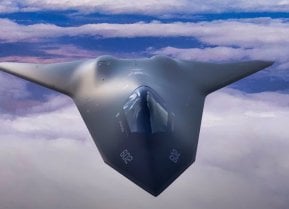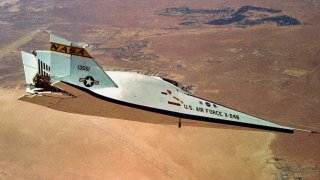The X-24B Is A True Aviation Legend for a Reason
The surviving X-24B is now in the Allan and Malcolm Lockheed and Glenn Martin Space Gallery at the National Museum of the United States Air Force. It is even more impressive in person.
The X-24B Lifting Body Paved the Way for the Space Shuttle - In the collection of the National Museum of the United States Air Force at Wright-Patterson Air Force Base (AFB), Dayton, Ohio, is a largely forgotten aircraft that could be easily overlooked – especially considering the notable planes that are on display.
This is the Martin X-24B, an aircraft that was developed to highlight how a "lifting body" – a fixed wing air or spacecraft – could glide through the atmosphere and make a precise landing on a runway like an airplane. The X-24 studies supported space shuttle development in the early 1970s.
What is a Lifting Body?
A lifting body is a rather straight forward concept—the body of a fixed-wing air or spacecraft provides the lift. Aerodynamic lift, which is essential to flight in the atmosphere, is obtained from the shape of the vehicle rather than from its wings, such as on a normal aircraft, while more importantly lifting body might not even have wings.
However, prior to 1957, the concept of a lifting body aircraft was thought to be pure science fiction. It was the work of Dr. Alfred J. Eggers Jr. – then the assistant director for Research and Development Analysis and Planning at the Ames Aeronautical Laboratory, now NASA's Ames Research Center in California's Silicon Valley.
Eggers showed that by altering a symmetrical nose cone shape, an aircraft was more likely to survive reentry from space. With the right wingless shape, the theory went, and a safe return from space to Earth might be possible.
The joint program, which ran from 1963-1975, was used to demonstrate the ability of pilots to maneuver and safely land wingless vehicles that were designed to fly back to Earth from space and be landed like an airplane at a predetermined site.
The X-24A, which was built by Martin Aircraft (now Lockheed Martin) for the U.S. Air Force, had a bulbous shape that resembled a teardrop that lacked wings. It was 6,270 pounds, 24.5 feet long and 11.5 feet wide at the fuselage. To the untrained eye its bomb-like shape would only be good for getting to the ground rapidly, but the engineers understood that its rocket engine could propel the vehicle into the sky at speeds approaching Mach 1, while its three vertical fins at the rear provided the direction control.
X-24: Taking Flight
The Martin X-24A's first unpowered glide flight was on April 17, 1969, with Air Force Major Jerauld Gentry at the controls. Nearly a year later Gentry also piloted the squat little craft on its first powered flight on March 19, 1970. Gentry was able to successfully control the X-24A, which descended sharply "like a streaking hang glider" and maneuver it to the ground.
As Lockheed Martin has noted with the successful touchdown of the X-24A, "The grandfather of the modern space shuttle had been born."
The pilot was further able to perform an unpowered landing on a dry lakebed near the NASA Flight Research Center. The X-24 became the ultimate "proof of concept" for the NASA scientists; as it showed that it was possible for a wingless aircraft to descend from the upper atmosphere and glide safely back to the Earth.
The experimental aircraft was flown 28 times and helped validate the concept that a Space Shuttle vehicle could be landed unpowered. In its fastest speed test, the X-24A achieved 1,036mph or MACH 1.6, while its maximum altitude was 71,400, which was to simulate a shuttle landing approach. Typical flights lasted under eight minutes and included a 2.5 minute rocket burn followed by a 5 minute glide to landing.
Enter the X-24B
The X-24A was modified into the X-24B where its bulbous shape was converted into a "flying flatiron" that had a rounded top, flat bottom and double delta platform that ended in a pointed nose to improve its gliding qualities, increasing range and maneuverability.
In this configuration the aircraft further demonstrated that accurate unpowered reentry vehicle landings were operationally feasible. On August 5, 1971, the X-24B made the first successful landing of a lifting body vehicle on a conventional airplane runway.
While the program is today largely forgotten it certainly paved the way for the Space Shuttle, while the shape of the X-24A was later borrowed for the X-38 Crew Return Vehicle (CRV) technology demonstrator for the International Space Station (ISS)
The X-24B was the last joint USAF/NASA rocket-powered air-launched research aircraft.
However, as Lockheed Martin also noted, "The spirit of the X-24 lived on. When NASA began work on a prototype vehicle for transporting astronauts back to Earth from the International Space Station in the mid-1990s, it was the X-24A's famous teardrop design that was chosen, a fitting tribute to a potato-shaped wonder that helped usher in a new era of manned space flight."
The surviving X-24B is now in the Allan and Malcolm Lockheed and Glenn Martin Space Gallery at the National Museum of the United States Air Force. It is even more impressive in person.
Author Experience and Expertise
Peter Suciu is a Michigan-based writer. He has contributed to more than four dozen magazines, newspapers, and websites with over 3,200 published pieces over a twenty-year career in journalism. He regularly writes about military hardware, firearms history, cybersecurity, politics, and international affairs. Peter is also a Contributing Writer for Forbes and Clearance Jobs. You can follow him on Twitter: @PeterSuciu.


